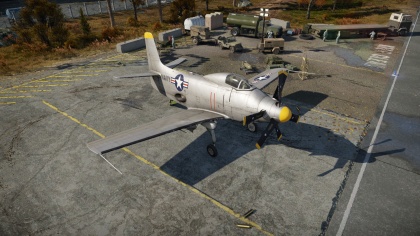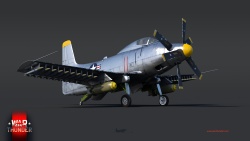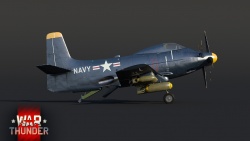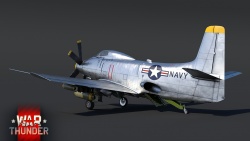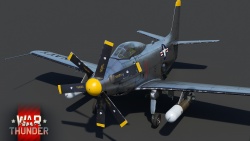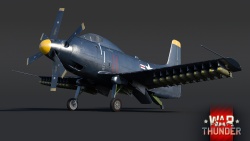A2D-1
Contents
Description
The A2D-1 Skyshark is a premium rank V American attacker
with a battle rating of 9.0 (AB) and 7.0 (RB/SB). It was introduced in Update 1.89 "Imperial Navy".
The Douglas A-1 Skyraider was an impressive aircraft for a piston-driven propeller-powered aircraft which survived into the jet age, being used by the United States Navy, Marine Corps and Air Force and around nine other countries over its 40-year service. Like many aircraft which were successful, they went through many iterations and variants to keep them up to date with new requirements and technology as they came about. In an age where jet aircraft were beginning to overtake propeller-driven aircraft in all aspects of military service, the Bureau of Aeronautics which was the U.S. Navy’s material-support organization was looking for a suitable option for an attack aircraft which would be more fuel-efficient than the upcoming jet fighters. To meet the Navy’s requirement, Douglas Aircraft looked to their AD Skyraider airframe and considered modifying it to accept a more fuel economical turboprop engine.
The A2D-1 was outfitted with the Allison XT40A turboprop engine, effectively doubling the horsepower over the Skyraider, however, installation of contra-rotating propellers was needed to harness all of that power. To accommodate this new power, the wing roots were decreased in their thickness while the tail section became larger and taller in order to stabilize the aircraft when under power. With the new engine situated it was time to focus on the armament of the aircraft. Basic offensive 20 mm cannons were implemented, placing two in each wing with each gun being loaded with 400 rounds of ammunition. Since the autocannons were mounted in the wings, the pilot must be cognizant of their range to the target and their convergence setting to ensure the ammunition hits the target and doesn’t just fly on by.
Twenty-two total hardpoints allow the A2D-1 to carry an abundance of suspended ordnance much like the Skyraider. Choices of bombs, rockets and torpedoes open up the possibility of targets which can be engaged. Choices in bombs provide options with either 250 lb, 500 lb, 1,000 lb and 2,000 lb bombs. With these targets can range from mobile light trucks, anti-aircraft artillery, tanks, pillboxes and even bases. HVAR rockets provide flexibility to allow the A2D-1 to fire them from any angle (a restriction which bombs have) as the aircraft descends towards the target. The Mk.13/44 torpedoes are outfitted with a special frangible wooden drag ring and box stabilizer which allow for the torpedo to be dropped at high speeds and from higher altitudes than unmodified torpedoes making them a perfect option for the A2D-1 when taking on an anti-shipping role.
The Douglas A2D-1 did not have the same legacy as the A-1 Skyraider, however here in War Thunder new life has been given to this hybrid turbo-prop fighter allowing it to find a niche as an attacker turned fighter and/or bomber, all depending on the ordnance outfitted by the pilot. Not to be underestimated, though having a bulky airframe, the A2D-1 has the speed and ordnance which can help in turning the tide of a battle. Often this aircraft will come up against jet aircraft, but its lack of speed can be made up in manoeuvrability and skill of the pilot in command.
General info
Flight performance
Describe how the aircraft behaves in the air. Speed, manoeuvrability, acceleration and allowable loads - these are the most important characteristics of the vehicle.
| Characteristics | |||||||
|---|---|---|---|---|---|---|---|
| Stock | |||||||
| Max Speed (km/h at 8,534 m) |
Max altitude (meters) |
Turn time (seconds) |
Rate of climb (meters/second) |
Take-off run (meters) | |||
| AB | RB | AB | RB | AB | RB | ||
| 796 | 796 | 13200 | 20.6 | 21.2 | 32.4 | 32.1 | 350 |
| Upgraded | |||||||
| Max Speed (km/h at 8,534 m) |
Max altitude (meters) |
Turn time (seconds) |
Rate of climb (meters/second) |
Take-off run (meters) | |||
| AB | RB | AB | RB | AB | RB | ||
| 796 | 796 | 13200 | 19.5 | 20.0 | 36.4 | 34.4 | 350 |
Details
| Features | ||||
|---|---|---|---|---|
| Combat flaps | Take-off flaps | Landing flaps | Air brakes | Arrestor gear |
| ✓ | ✓ | ✓ | ✓ | ✓ |
| Limits | ||||
|---|---|---|---|---|
| Wing-break speed (km/h) |
Gear limit (km/h) |
Combat flaps (km/h) |
Max Static G | |
| + | - | |||
| 600 | ~9 | ~4 | ||
| Optimal velocities | |||
|---|---|---|---|
| Ailerons (km/h) |
Rudder (km/h) |
Elevators (km/h) |
Radiator (km/h) |
| < 460 | < 480 | < 460 | N/A |
| Compressor (RB/SB) | ||
|---|---|---|
| Setting 1 | ||
| Optimal altitude | 100% Engine power | WEP Engine power |
| 1,000 m | 5,034 hp | N/A |
Survivability and armour
The A2D1 has no protection for the Pilot which makes it very vulnerable to AAA and other Aircraft. The radar is also vulnerable. Belly landings normally result in the tail being ripped off and the aircraft breaking the wings. The engines perform well even when damaged and can fly with one heavily damaged and one operational. Rolling with negative G's can rip the wings off. Fires can be quite common.
Armaments
Offensive armament
The A2D-1 is armed with:
- 4 x 20 mm T31 cannons, wing-mounted (200 rpg = 800 total)
Suspended armament
The A2D-1 can be outfitted with the following ordnance:
- Without load
- 20 x 250 lb AN-M57 bombs (5,000 lb total)
- 20 x HVAR rockets
- 10 x 500 lb AN-M64A1 bombs (5,000 lb total)
- 2 x 1,000 lb AN-M65A1 bombs (2,000 lb total)
- 2 x 2,000 lb AN-M66A2 bombs (4,000 lb total)
- 2 x 2,000 lb AN-M66A2 bombs + 8 x 500 lb AN-M64A1 bombs (8,000 lb total)
- 2 x 2,000 lb AN-M66A2 bombs + 20 x HVAR rockets (4,000 lb total)
- 2 x Mk.13/44 torpedoes
Usage in battles
In Realistic Battles, the A2D-1 can climb with no extra armament and can be top cover for the props or it can escort bombers. It can also carry one of its most hard hitting armaments and destroy several ground targets or destroy two bases. The A2D-1 is a very valuable asset to teams looking to win by destroying troops or the airfield. The A2D-1 can also excel in air combat with an armament of four 20 mm T31 cannons, these are accurate and can rip parts off of other aircraft. The main air-to-air combat style is boom-and-zoom as this aircraft has no amour for the pilot.
Radars
The A2D-1 is equipped with an AN/APS-19 search and tracking radar. The radar is mounted in nose, inside the propeller hub.
| AN/APS-19 - Target Detection Radar | |||
|---|---|---|---|
| Maximum Detection Range |
Guaranteed Detection Range |
Max Azimuth Scan Angle |
Max Elevation Scan Angle |
| 60,000 m (theoretical) |
7,200 m | ±67.5° | ±67.5° |
| AN/APS-19 - Target Tracking Radar | |||
| Maximum Tracking Range |
Minimum Tracking Range |
Azimuth Tracking Angle |
Elevation Tracking Angle |
| 1,500 m | 150 m | ±15° | ±15° |
Manual Engine Control
| MEC elements | ||||||
|---|---|---|---|---|---|---|
| Mixer | Pitch | Radiator | Supercharger | Turbocharger | ||
| Oil | Water | Type | ||||
| Not controllable | Not controllable Not auto controlled |
Not controllable Auto control available |
Not controllable Auto control available |
Combined | Not controllable 1 gear |
Not controllable |
Modules
| Tier | Flight performance | Survivability | Weaponry | |||
|---|---|---|---|---|---|---|
| I | Fuselage repair | Radiator | Offensive 20 mm | M64 | ||
| II | Compressor | Airframe | M65 | FRC mk.2 | ||
| III | Wings repair | Engine | New 20 mm cannons | Mk.13 | ||
| IV | Cover | M66 | ||||
- As a premium aircraft, the A2D-1's modifications are automatically unlocked upon purchase of the aircraft.
Pros and cons
Pros:
- Possesses tracking and search Radar
- 20 mm cannon armament
- Naval aircraft capable of carrier-landing
- Powerful turboprop dual engines
- Impressive payload options of bombs, rockets or torpedoes
- Premium bonuses
Cons:
- Time limit on radar
- Tracking Radar only works at < 1 km
- Extremely large profile for an attacker
- Tail of aircraft is fragile
- Rather slow aircraft compared to its enemy competitors
History
In the early years following the war, jet engines underwent rapid development. This attracted the interest of the US Navy, which sought to arm itself with aircraft that were superior to that of potential opponents in speed, altitude, payload, and flight range.
As it turned out, jet engines were perfect for fighter aircraft but too “voracious” for strike aircraft, as they significantly reduced their range. The best engineering solution was to introduce the turboprop engine, which was a task the Douglas company undertook.
Initially, engineers simply wanted to replace the piston engine of the Skyraider attack aircraft with a turboprop engine. However, this led nowhere and the vehicle required significant modification. In the end, the engineers settled on a prototype with Allison Т-40А-2 turboprop engines and coaxial propellers.
The first flight of the XA2D-1 prototype, called the Skyshark, took place on May 26, 1950, but engine vibration nearly destroyed the aircraft and it was forced to land after only two minutes. By December 1950, the prototype had already completed over a dozen flights. However, a routine flight on December 19, 1950, ended in tragedy. Due to issues with the engine, the vehicle and pilot crashed. Nevertheless, testing continued and, despite the many technical problems that plagued the aircraft, the army ordered 10 pre-production models of the A2D-1. However, on August 5, 1954, another accident occurred when the main gearbox failed, and the aircraft crashed a short distance outside Los Angeles. This time, the pilot managed to escape the aircraft, but the project was closed and it was decided to dismantle any existing prototypes. Apparently, this decision was influenced by the fact that in the same year for the first time Douglas got another project in the air, this later became the famous A4D Skyhawk - a new generation of jets.
- From Devblog
Media
- Images
- Videos
See also
- Related development
- Aircraft of comparable role, configuration and era
- Westland Wyvern S4
External links
| Douglas Aircraft Company | |
|---|---|
| Strike Aircraft | A-20G-25 · A-26B-10 · A-26B-50 · AD-2 · AD-4 · A-1H |
| Bombers | TBD-1 · B-18A · SBD-3 · BTD-1 · A-26C-45 · A-26C-45DT |
| Turboprops | A2D-1 |
| Jet Aircraft | F3D-1 · F4D-1 |
| A-4 Skyhawk | A-4B · A-4E Early |
| Export | ▄Havoc Mk I · ▄Boston Mk I · ▄DB-7 · ▂A-20G-30 · ▄AD-4 · ▄AD-4NA |
| A-4 Skyhawk | A-4H · A-4E Early (M) · Ayit · A-4E |
| The Douglas Aircraft Company merged with McDonnell Aircraft Corporation in 1967 to form McDonnell Douglas. | |
| USA strike aircraft | |
|---|---|
| Douglas | A-20G-25 · A-26B-10 · A-26B-50 · A2D-1 · AD-2 · AD-4 · A-1H |
| North American | A-36 · PBJ-1H · PBJ-1J |
| Other | AM-1 · AU-1 · XA-38 |



